On the Ecological Compensation Standard of Cultivated Land Under the “Separation of Three Rights”: From the Perspective of Contract Rights
Abstract
1. Introduction
2. Research Framework and Methods
2.1. Calculation of Ecological Value
2.1.1. Calculation of Positive Value
2.1.2. Calculation of Negative Value
2.2. Calculation of Opportunity Cost Loss
2.3. Calculation of Compensation Standard Applicable to Contractual Rights Holders
- Ecological compensation standard for contracted farming households under non-transferring conditions:
- 2.
- Ecological compensation standard for contracted farming households under transferring conditions:
2.4. Data Source
3. Empirical Analysis
3.1. Calculation Results of the Positive Value of Cultivated Land Ecosystem Services in Jiangsu Province
3.2. Calculation Results of Negative Value of Cultivated Land Ecosystem Services in Jiangsu Province
3.3. Loss of Opportunity Cost for Cultivated Land Protection in Jiangsu Province
3.4. Calculation of Compensation Standard for Contracted Farmers in Jiangsu Province
4. Discussion
- (1)
- Compensation for Transferred Contracted Farmers Based on Opportunity Cost: This compensation mechanism is primarily government funded. It involves establishing multi-level government compensation schemes, where municipal and district governments contribute proportionally, or creating a cultivated land protection special fund. Tiered compensation standards are formulated based on regional development levels. Funds are centrally allocated to rural communities and distributed proportionally to village collectives and contracted farmers, incentivizing farmer collectives to engage in cultivated land protection.
- (2)
- Non-transferred contracted farmers, based on ecological value and opportunity cost loss compensation: The establishment of a government-market-community collaborative compensation mechanism is suggested, to alleviate fiscal pressure on the government. Compensation for opportunity cost losses can be achieved through government compensation; compensation for ecological value should be realized by improving the market trading platform for ecological products, leveraging the community co-governance mechanism to exercise ownership rights, implementing unified planning for rural ecological products with collective pricing, and utilizing the leveraging role of financial markets in rural economies. Equity participation mechanisms should be adopted to compensate contracted farmers, thereby sharing the government’s compensation burden.
- (3)
- Dynamic adjustment of compensation standards: The establishment of compensation standards for contracted farmers constitutes a key factor in balancing and coordinating the interests of the three rights holders in cultivated land ecological compensation. It must consider both the willingness to accept compensation and the payment capacity of local governments while also addressing regional disparities. Therefore, it is essential to introduce price mechanisms and implement dynamic adjustment mechanisms aligned with current economic development levels. By enhancing public participation, such approaches can ensure the effectiveness and sustainability of compensation policies.
- (4)
- Supporting measures: First, accelerate the certification of land contract rights to safeguard contracted farmers’ access to related benefits. Second, promote innovation in green development models by reducing chemical fertilizer and pesticide usage, mitigating negative impacts on cultivated land ecosystem services and increasing the supply of high-quality agricultural products. Third, optimize agricultural production layouts and advance ecological certification of agricultural products, achieving compensation for non-transferred contracted farmers through brand premium strategies.
5. Conclusions
- Contracted farming households engaged in land transfer: The compensation standard is primarily based on opportunity costs, calculated as the difference between the revenue generated from converting cultivated land to construction land and the income from grain market transactions. This compensates for the economic benefits lost due to foregone development opportunities resulting from cultivated land protection. For contracted farming households engaged in land transfers, since they do not directly invest in agricultural production on the contracted land, the ecological value associated with crop cultivation is excluded from the compensation standard. The calculation results reveal that only Nanjing, Wuxi, and Suzhou demonstrate compensation standards exceeding 10,000 CNY/ha for contracted farming households engaged in land transfers. The provincial average in Jiangsu stands at 6275.79 CNY/hm2.
- Contracted farming households not engaged in land transfer: Compensation should encompass not only the ecological value associated with agricultural products but also the opportunity costs incurred. Ecological values associated with agricultural products encompass both positive and negative values, with their differential constituting the net ecological value. The assessment results of positive values demonstrate that cultivated land exhibits significant ecological value. The region with the highest positive value of cultivated land ecosystem services is Huaian City, at 192,300 CNY/hm2, while the lowest is Zhenjiang City, at 64,700 CNY/hm2. The negative values encompass those generated by chemical inputs, agricultural water consumption, residual plastic mulch, and greenhouse gas emissions, with fertilizer/pesticide use and agricultural water consumption constituting the predominant components. The average compensation standard for non-transferred contracted farmers within the region stands at 40,604 CNY/hm2, with the net ecological value constituting the predominant component.
- Comparative analysis of compensation standards between transferred and non-transferred contracted farmers: Non-transferred contracted farmers require compensation not only for opportunity cost losses but also for the ecological value generated through agricultural production, resulting in significantly higher compensation standards compared to their transferred counterparts. In Jiangsu Province, regional variations in compensation for transferred farmers align closely with regional economic development level, exhibiting gradient decrease from south to north geographically. Conversely, compensation standards for non-transferred farmers demonstrate more pronounced regional disparities. The compensation standard for contracted farming households without land transfer is primarily determined by the net ecological value and is closely associated with opportunity cost losses. The generation of ecological value depends on grain production: when both grain yield per unit area and opportunity cost losses are high, the compensation standard in such regions is correspondingly higher, whereas when both factors are lower, the compensation standard decreases accordingly. Consequently, the compensation standards for non-transferred contracted farming households demonstrate significantly pronounced spatial heterogeneity across different regions.
Author Contributions
Funding
Data Availability Statement
Conflicts of Interest
References
- Li, J.; Chen, X.; De Maeyer, P.; Van de Voorde, T.; Li, Y. Investigating the supply–demand gap of farmland ecosystem services to advance sustainable development goals (SDGs) in Central Asia. Agric. Water Manag. 2025, 312, 109419. [Google Scholar] [CrossRef]
- Ecological Protection Compensation Regulations. Website of Xining City Central District People’s Government. 28 May 2024. Available online: https://www.xncz.gov.cn/info/3319/185585.htm (accessed on 10 April 2025).
- Liu, M.; Yang, L.; Min, Q. Establishment of an eco-compensation fund based on eco-services consumption. J. Environ. Manag. 2018, 211, 306–312. [Google Scholar] [CrossRef]
- Gao, F.; Zhou, J.; Jiang, H.; Yang, W.; Wang, G. Assessing the true value of ecological restoration in mining areas: An input-output approach based on ecosystem service valuation. Ecol. Indic. 2024, 166, 112591. [Google Scholar] [CrossRef]
- Zhang, B.; Feng, Q.; Lu, Z.; Li, Z.; Zhang, B.; Cheng, W. Ecosystem service value and ecological compensation in Qilian Mountain National Park: Implications for ecological conservation strategies. Ecol. Indic. 2024, 167, 112661. [Google Scholar] [CrossRef]
- Sheng, W.; Zhen, L.; Xie, G.; Xiao, Y. Determining eco-compensation standards based on the ecosystem services value of the mountain ecological forests in Beijing, China. Ecosyst. Serv. 2017, 26, 422–430. [Google Scholar] [CrossRef]
- Jia, Y.; Liu, Y.; Zhang, S. Evaluation of agricultural ecosystem service value in arid and semiarid regions of northwest China based on the equivalent factor method. Environ. Process. 2021, 8, 713–727. [Google Scholar] [CrossRef]
- Zhen, H.; He, X.; Qiao, Y.; Ju, X.; Xu, Z.; Hashemi, F.; Knudsen, M.T. Does organic agriculture need eco-compensation? Evidence from Chinese organic farms using an eco-compensation model. Sustain. Prod. Consum. 2024, 49, 72–81. [Google Scholar] [CrossRef]
- Wang, Y.; Cai, Y.; Liu, G.; Zhang, P.; Li, B.; Li, B.; Jia, Q.; Huang, Y.; Shu, T. Evaluation of sustainable crop production from an ecological perspective based emergy analysis: A case of China’s provinces. J. Clean. Prod. 2021, 313, 127912. [Google Scholar] [CrossRef]
- Kniivilä, M. Users and non-users of conservation areas: Are there differences in WTP, motives and the validity of responses in CVM surveys? Ecol. Econ. 2006, 59, 530–539. [Google Scholar] [CrossRef]
- Zhang, Z.; Cui, Y.; Wang, L.; Sun, X.; Gao, Y. Determining the ecological compensation standards based on willingness to accept (WTA) for intensive agricultural production areas: A case in China. Appl. Geogr. 2023, 158, 103051. [Google Scholar] [CrossRef]
- Loomis, J.; Kent, P.; Strange, L.; Fausch, K.; Covich, A. Measuring the total economic value of restoring ecosystem services in an impaired river basin: Results from a contingent valuation survey. Ecol. Econ. 2000, 33, 103–117. [Google Scholar] [CrossRef]
- Zhou, S.; Huang, Y.; He, H.; Zhang, Z. Focusing on structural changes and future risks of ecosystems: An opportunity-cost based ecosystem service account for riparian ecosystems and its case study. Ecol. Indic. 2024, 158, 111523. [Google Scholar] [CrossRef]
- Guan, D.; Xi, Q.; Su, X.C.; Liu, X.; Zhou, L.; Liu, Z. Quantification and multiscenario simulation of ecological compensation and economic development coupling relationships in the YRB, China. Ecol. Indic. 2024, 168, 112760. [Google Scholar] [CrossRef]
- Hu, P.; Zhou, Y.; Zhou, J.; Wang, G.; Zhu, G. Uncovering the willingness to pay for ecological red lines protection: Evidence from China. Ecol. Indic. 2022, 134, 108458. [Google Scholar] [CrossRef]
- Kong, F.; Xiong, K.; Zhang, N. Determinants of Farmers’ Willingness to Pay and Its Level for Ecological Compensation of Poyang Lake Wetland, China: A Household-Level Survey. Sustainability 2014, 6, 6714–6728. [Google Scholar] [CrossRef]
- Zhen, H.; Qiao, Y.; Zhao, H.; Ju, X.; Zanoli, R.; Waqas, M.A.; Lun, F.; Knudsen, M.T. Developing a conceptual model to quantify eco-compensation based on environmental and economic cost-benefit analysis for promoting the ecologically intensified agriculture. Ecosyst. Serv. 2022, 56, 101442. [Google Scholar] [CrossRef]
- Reed, M.S.; Moxey, A.; Prager, K.; Hanley, N.; Skates, J.; Bonn, A.; Evans, C.D.; Glenk, K.; Thomson, K. Improving the link between payments and the provision of ecosystem services in agri-environment schemes. Ecosyst. Serv. 2014, 9, 44–53. [Google Scholar] [CrossRef]
- Lu, Z.; Wu, X.; Zhang, S.; Li, J.; Cai, F.; Xu, R. A study of ecological compensation in watersheds based on the three-way decisions theory. J. Clean. Prod. 2022, 368, 133166. [Google Scholar] [CrossRef]
- Luan, R.; Wen, G.; Hu, X.; Lin, X.; Zhang, C. Eco-compensation for Farmers’ cultivated land protection based on Field-Habitus theory. Ecol. Indic. 2025, 172, 113319. [Google Scholar] [CrossRef]
- Ainiwaerjiang, A.; Jin, X.; Xie, Z.; Tian, T.; Dang, Y. Research on the multi-agent motivation coupling evolution and synergy improvement for farmland ecological protection in China. Environ. Sustain. Indic. 2025, 25, 100583. [Google Scholar] [CrossRef]
- Shen, N.; Pang, A.; Li, C.; Liu, K. Study on Ecological Compensation Mechanism of Xin’an Spring Water Source Protection Zone in Shanxi Province, China. Procedia Environ. Sci. 2010, 2, 1063–1073. [Google Scholar] [CrossRef]
- Kuai, C.; Huang, Y.; Wang, F. A framework for eco-compensation in the Yangtze River Delta region of China based on multiple policy objectives. J. Clean. Prod. 2024, 436, 140370. [Google Scholar] [CrossRef]
- Liu, M.; Chen, C.; Yang, L.; Min, Q.; Xiong, Y. Agricultural eco-compensation may not necessarily reduce chemical inputs. Sci. Total Environ. 2020, 741, 139847. [Google Scholar] [CrossRef]
- Yang, Y.; Zhu, Y.; Zhao, Y. Improving farmers’ livelihoods through the eco-compensation of forest carbon sinks. Renew. Sustain. Energy Rev. 2024, 198, 114401. [Google Scholar] [CrossRef]
- Chi, C.; Shen, J.; Huang, X.; Gao, X.; Hu, P.; Sun, F. A new framework for eco-compensation funds allocation in China based on multi-attribute decision-making method. Environ. Impact Assess. Rev. 2025, 114, 107891. [Google Scholar] [CrossRef]
- Ritten, J.; Fernández-Giménez, M.E.; Pritchett, J.; Kachergis, E.; Bish, W. Using State and Transition Models to Determine the Opportunity Cost of Providing Ecosystem Services. Rangel. Ecol. Manag. 2018, 71, 737–752. [Google Scholar] [CrossRef]
- da Motta, R.S.; Ortiz, R.A. Costs and perceptions conditioning willingness to accept payments for ecosystem services in a Brazilian case. Ecol. Econ. 2018, 147, 333–342. [Google Scholar] [CrossRef]
- Yan, J.; Yang, Y.; Xia, F. Subjective land ownership and the endowment effect in land markets: A case study of the farmland “three rights separation” reform in China. Land Use Policy 2021, 101, 105137. [Google Scholar] [CrossRef]
- Wang, Q.; Zhang, X. Three rights separation: China’s proposed rural land rights reform and four types of local trials. Land Use Policy 2017, 63, 111–121. [Google Scholar] [CrossRef]
- Zhang, Y.; Kant, S. Secure tenure or equal access? Farmers’ preferences for reallocating the property rights of collective farmland and forestland in Southeast China. Land Use Policy 2022, 112, 105814. [Google Scholar] [CrossRef]
- Gong, M.; Li, H.; Elahi, E. Three Rights Separation reform and its impact over farm’s productivity: A case study of China. Land Use Policy 2022, 122, 106393. [Google Scholar] [CrossRef]
- Gao, X.; Shi, X.; Fang, S. Property rights and misallocation: Evidence from land certification in China. World Dev. 2021, 147, 105632. [Google Scholar] [CrossRef]
- Cao, Y.; Bai, Y.; Zhang, L. The impact of farmland property rights security on the farmland investment in rural China. Land Use Policy 2020, 97, 104736. [Google Scholar] [CrossRef]
- Li, X.; Wang, Y.; Wang, Z. Quantifying the industrial development modes and their capability of realizing the ecological value in rural China. Technol. Forecast. Soc. Chang. 2024, 203, 123386. [Google Scholar] [CrossRef]
- Tzilivakis, J.; Warner, D.J.; Holland, J.M. Developing practical techniques for quantitative assessment of ecosystem services on farmland. Ecol. Indic. 2019, 106, 105514. [Google Scholar] [CrossRef]
- Liu, L.H.; Yang, B.R. Research on ecological compensation for cultivated land in China. China Popul. Resour. Environ. 2019, 29, 52–62. (In Chinese) [Google Scholar]
- Xie, G.; Zhang, C.; Zhen, L.; Zhang, L. Dynamic changes in the value of China’s ecosystem services. Ecosyst. Serv. 2017, 26, 146–154. [Google Scholar] [CrossRef]
- Liu, L.H.; Yang, Y.F.; Li, X.X. Research on Cultivated land protection compensation based on food security. J. Northwest AF Univ. (Soc. Sci. Ed.) 2017, 17, 30–38. (In Chinese) [Google Scholar] [CrossRef]

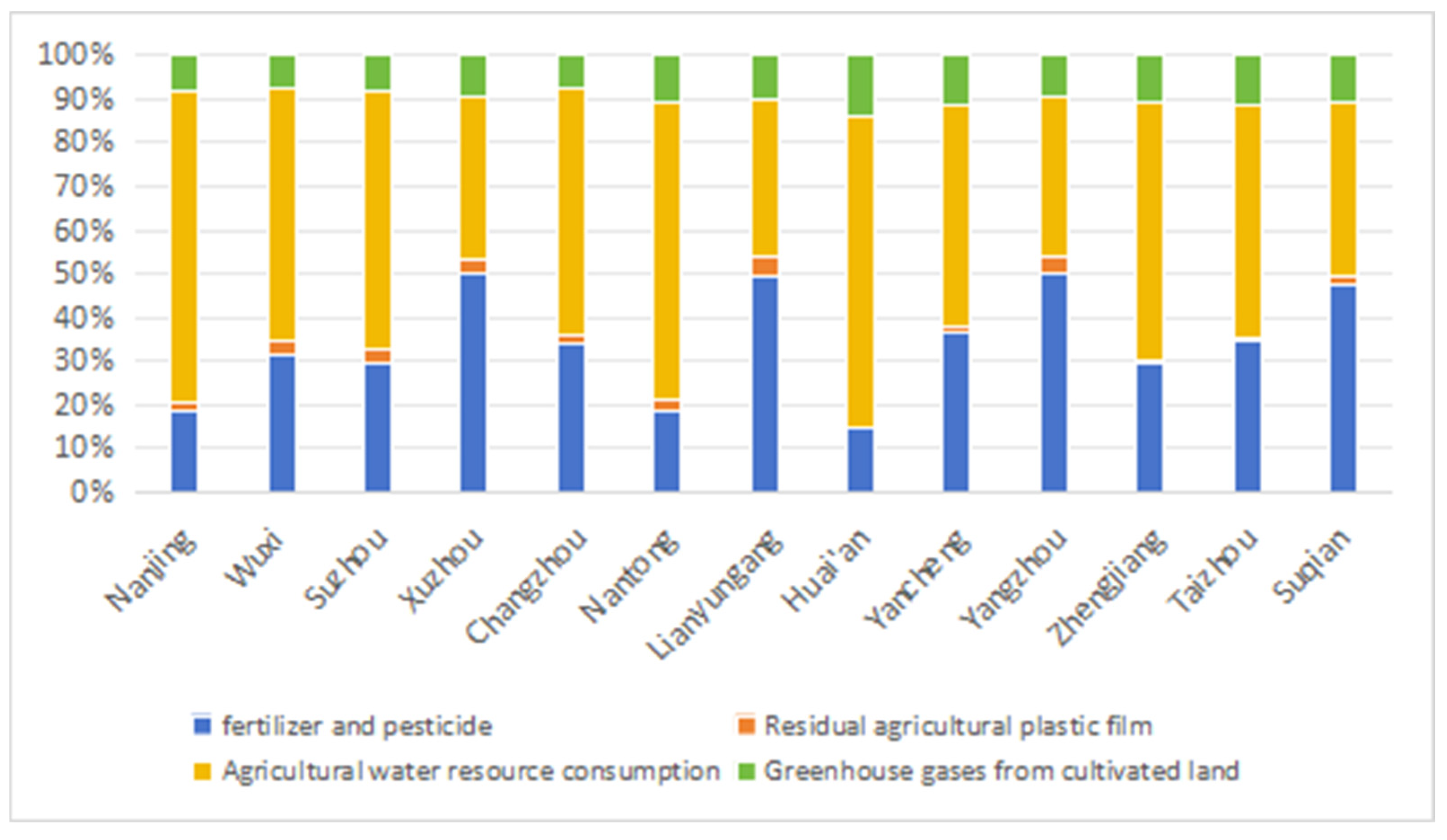
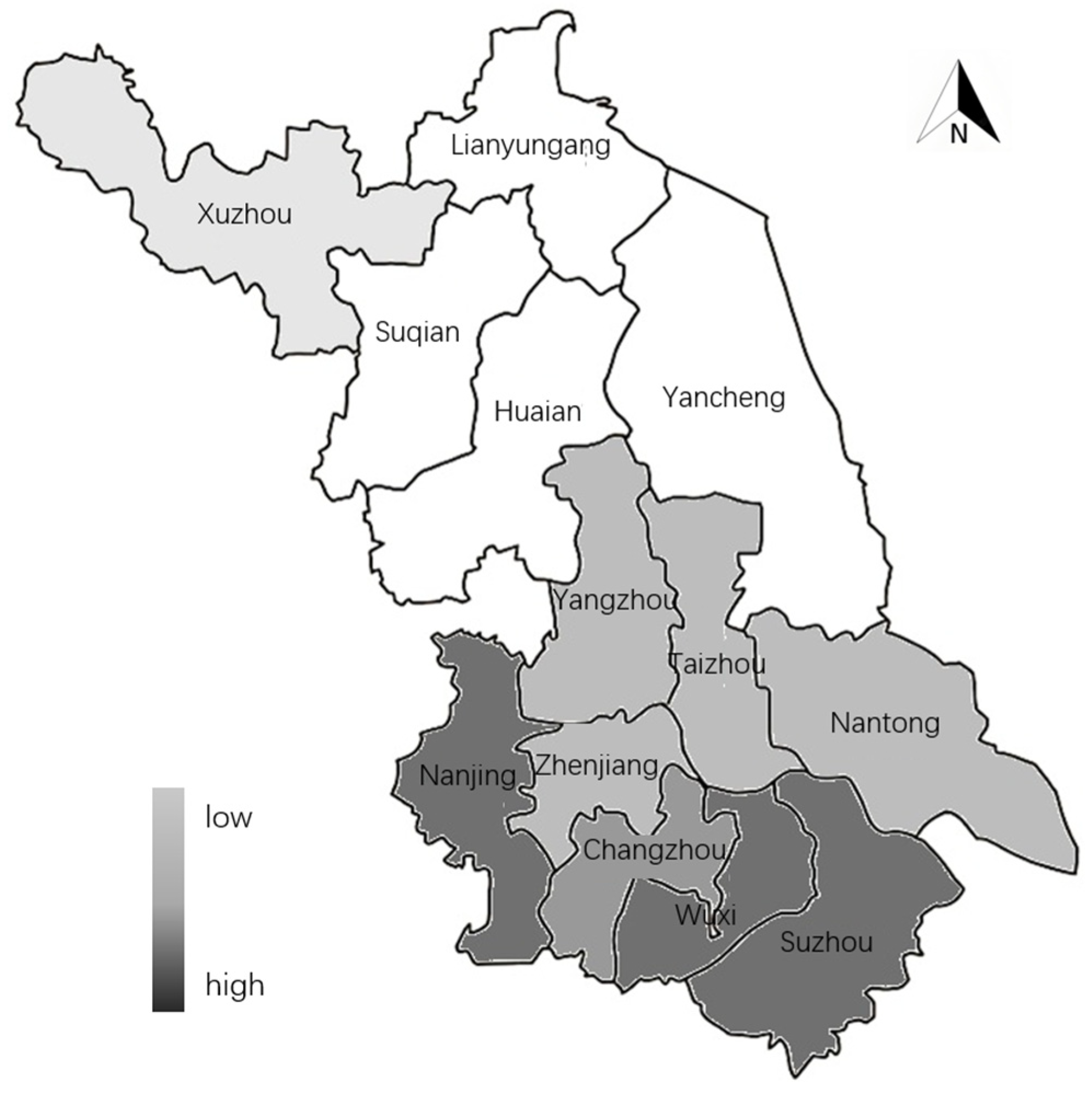
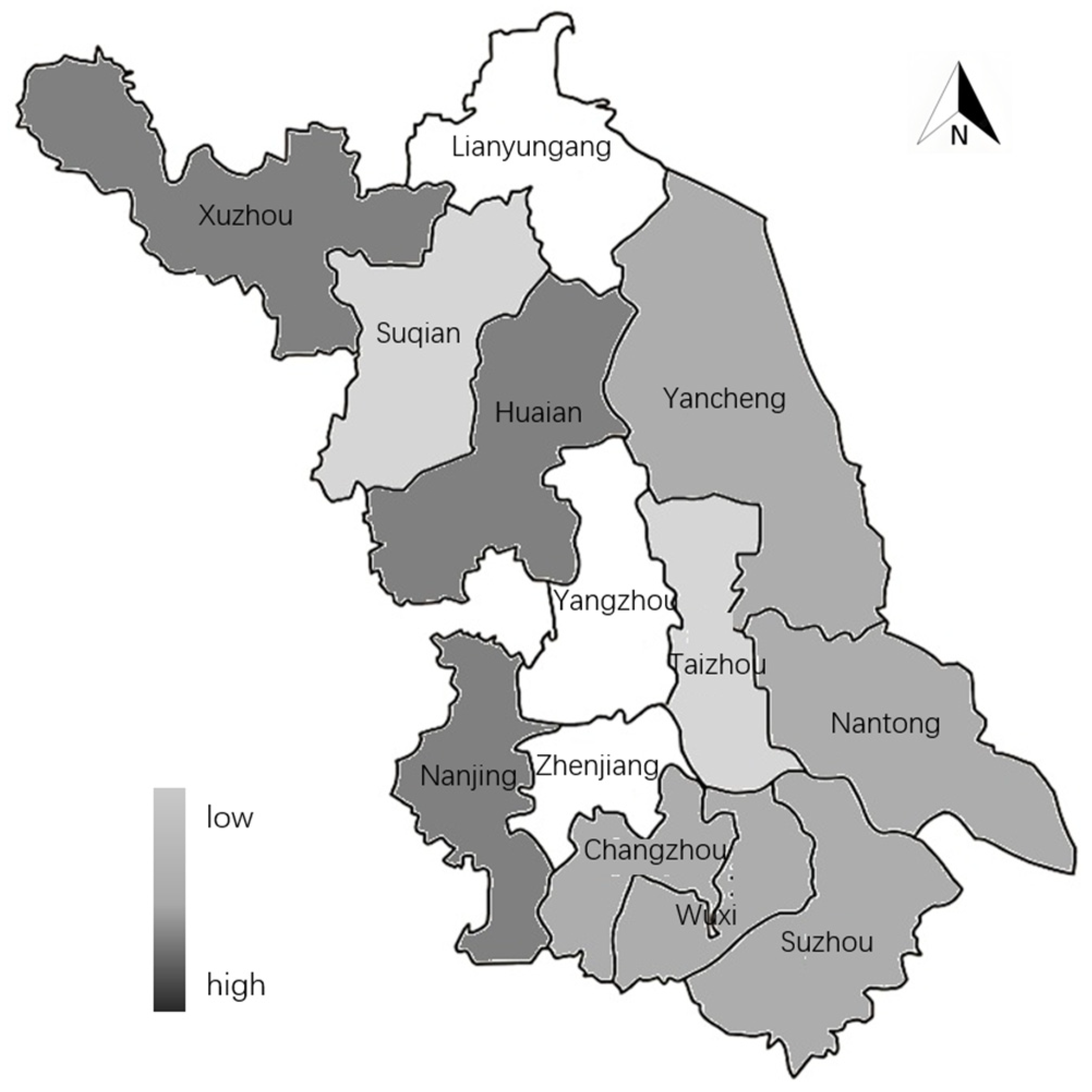
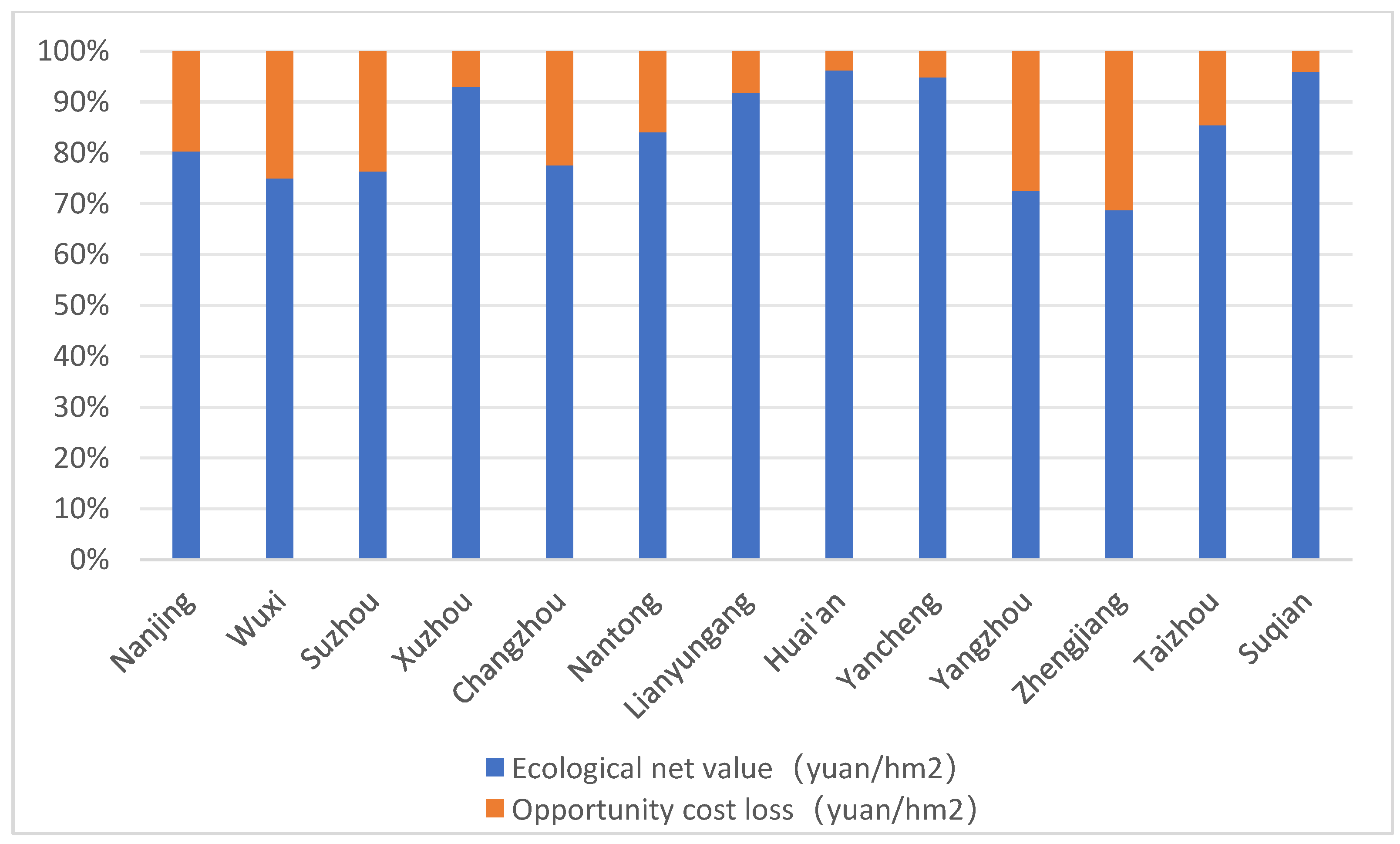
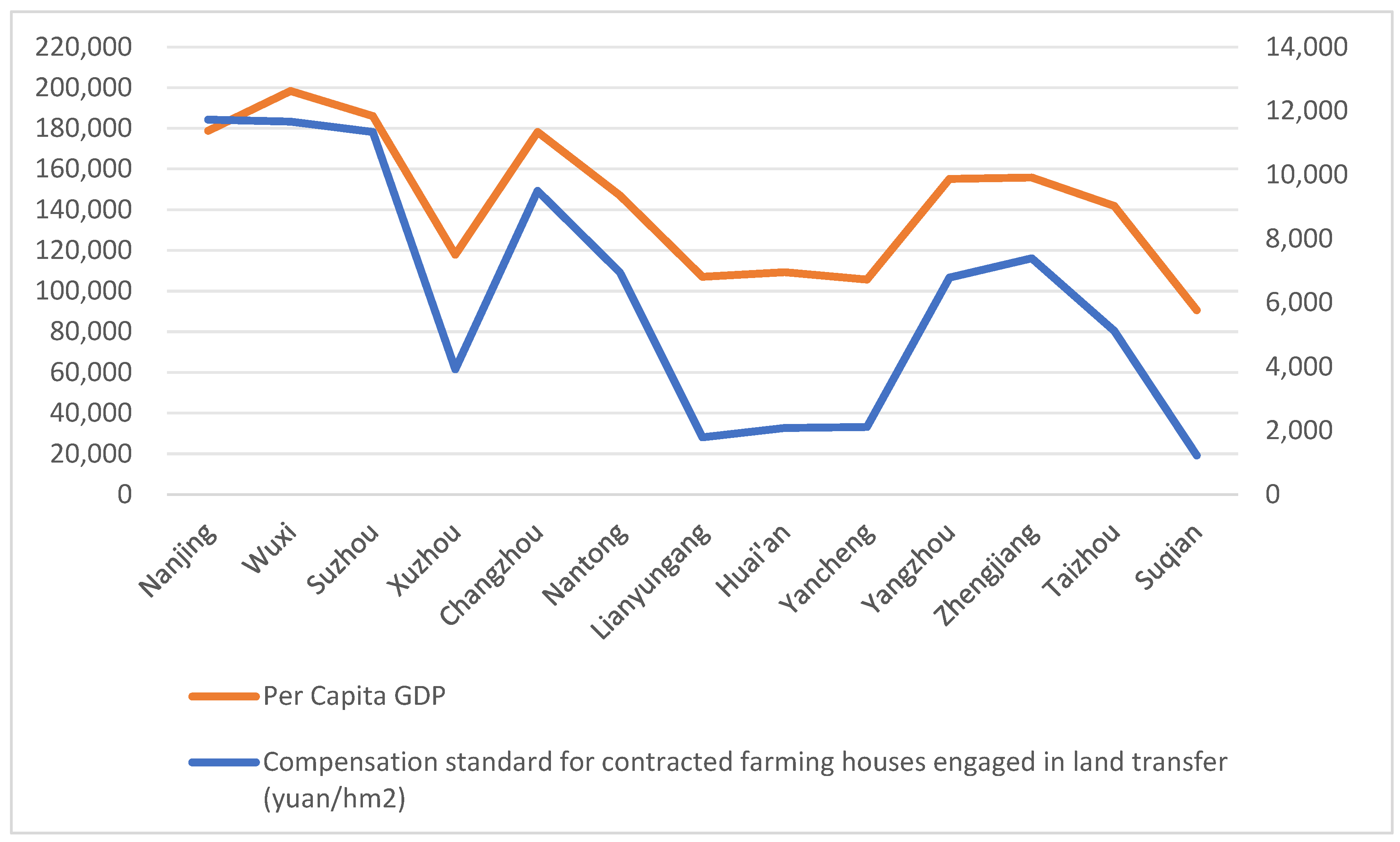

| Negative Value | Formula | Formula Explanation | Evaluation Method | |
|---|---|---|---|---|
| Total negative value | (3) | V2 is the negative value of cultivated land ecosystem services (CNY/hm2) in the study area in year i. VH, VW, VD, and VG are the negative values (CNY/hm2) generated by the use of chemical fertilizers and pesticides, consumption of agricultural water resources, residual agricultural mulch, and greenhouse gas emissions in the study area in year i, respectively. | Replacement Cost Method | |
| Fertilizer pesticide | (4) | FPi and NPi are the amount of chemical fertilizer (calculated by reduction method, kg) and pesticide (kg) used in the study area in year i; pfi and ppi are fertilizer price (CNY/kg) and pesticide price (CNY/kg) in the study area in year i. t1 and t2 are fertilizer utilization rate (%) and pesticide utilization rate (%), respectively. According to the research of relevant scholars, t1 is 34.17% and t2 is 35%. gi is the cultivated land area of the study area in year i (103 hm2). | ||
| Agriculture Water resources | (5) | Wci, Rwi, and Cw are respectively the year i of agricultural water consumption (108 m3), agricultural water consumption rate (%), and reservoir storage cost. The value of Cw combined with previous studies is 1.17 CNY/m3. | ||
| Residual agricultural mulch | (6) | Di, qyi, and pfi are the agricultural mulch cover area (hm2), grain yield per unit area (kg/hm2), and grain market price (CNY/kg) in the study area in year i. t3 and s are the mulch residue ratio (%) and grain loss rate (%), respectively. Combined with the research of relevant scholars, the value of t3 is 41.7% and the value of s is 10%. | ||
| Greenhouse gas | (7) | Pic and GWPij are the year i carbon trading price and year i global warming potential of Class j greenhouse gases; 27.27% is the content of C in CO2. | ||
| (8) | GGij, QCH4, and QN2O are Class j greenhouse gas emissions (kg) in year i, CH4 emissions (kg) in cultivated land, and N2O emissions (kg) in cultivated land. | |||
| (9) | mk and αk are the annual sown area (hm2) of the k crop and the CH4 emission coefficient per unit area of the k crop (kg/hm2). | |||
| (10) | mk and βk are the annual sown area (hm2) and the annual background N2O emission flux per unit area of the k crop (kg/hm2). Hk and Qck are the total annual nitrogen fertilizer application (kg) and total annual compound fertilizer application (kg) of the k crop. λk and δk are the N2O emission coefficients of nitrogen fertilizer and compound fertilizer of the k crop (%). | |||
| Data Category | Name | Data Sources |
|---|---|---|
| Ecological Value | total grain output, grain yield per unit area, cultivated land area, sown crop area, pesticide and fertilizer application rates, agricultural plastic mulch coverage area, and grain yield per unit area | 2023 statistical yearbooks of respective region, the official website of Jiangsu Reform and Development Commission, the official website of Jiangsu Provincial Bureau of Natural Resources, the official website of the regional Reform and Development Commission, the official website of the regional Natural resources Bureau, |
| grain prices, pesticide and fertilizer prices | National Agricultural Product Cost and Income Data Compilation 2023, Jiangsu Yearbook 2023, Jiangsu Survey Yearbook 2023 | |
| the source of agricultural water consumption | 2023 Jiangsu Water Resources Bulletin, the official website of the Jiangsu Water Resources Department, the official website of the regional Agriculture and Rural Bureau | |
| Opportunity Cost | Net proceeds from land conveyance, Transaction price of land use right, Deed tax rate | 2023 China Natural Resources Statistical Bulletin, Deed Tax Law of the People’s Republic of China, the official website of the Central People’s Government of the People’s Republic of China, the official website of the Jiangsu Provincial Department of Justice |
| Correction Factor | The one-year bank deposit rate, per capita GDP by region, per capita GDP of Jiangsu Province, per capita GDP of the whole country, multiple cropping index, Engel coefficient and CPI | the official website of the People’s Bank of China, the official website of regional Statistics Bureau, the official website of Jiangsu Provincial Statistics Bureau, the official website of China Macroeconomic Statistics for 30 Years, the Statistical Bulletin of National Economic and Social Development 2023 of each region |
| City | Ea (CNY/hm2) | Multiple Cropping Index | Positive Value (CNY/hm2) |
|---|---|---|---|
| Nanjing | 1.32 | 1.85 | 15.95 |
| Wuxi | 1.18 | 1.67 | 12.79 |
| Suzhou | 1.18 | 1.55 | 11.88 |
| Xuzhou | 1.38 | 2.11 | 18.94 |
| Changzhou | 0.95 | 1.96 | 12.16 |
| Nantong | 1.03 | 1.99 | 13.34 |
| Lianyungang | 0.87 | 1.71 | 9.65 |
| Huaian | 1.73 | 1.71 | 19.23 |
| Yancheng | 1.20 | 1.80 | 14.03 |
| Yangzhou | 0.76 | 1.46 | 7.27 |
| Zhenjiang | 0.80 | 1.24 | 6.47 |
| Taizhou | 0.93 | 1.92 | 11.61 |
| Suqian | 0.94 | 1.82 | 11.19 |
| City | Negative Value of Fertilizers and Pesticides (CNY/hm2) | Negative Value of Agricultural Water Consumption (CNY/hm2) | Negative Value of Agricultural Mulch (CNY/hm2) | Negative Value of Greenhouse Gases (CNY/hm2) | Total Negative Value (CNY/hm2) |
|---|---|---|---|---|---|
| Nanjing | 2297 | 8706 | 216 | 1022 | 12,242 |
| Wuxi | 3896 | 7218 | 428 | 932 | 12,474 |
| Suzhou | 3191 | 6401 | 319 | 902 | 10,811 |
| Xuzhou | 5512 | 4111 | 314 | 1051 | 10,988 |
| Changzhou | 5051 | 8376 | 230 | 1094 | 14,751 |
| Nantong | 1178 | 4227 | 169 | 695 | 6270 |
| Lianyungang | 5677 | 4129 | 529 | 1134 | 11,469 |
| Huaian | 938 | 4559 | 4 | 911 | 6411 |
| Yancheng | 3347 | 4669 | 162 | 1025 | 9202 |
| Yangzhou | 6675 | 4835 | 469 | 1274 | 13,253 |
| Zhenjiang | 2980 | 5977 | 55 | 1123 | 10,134 |
| Taizhou | 3488 | 5362 | 48 | 1141 | 10,040 |
| Suqian | 5016 | 4238 | 201 | 1129 | 10,583 |
| City | Annual Planting Area of Rice × 104 (hm2) | CH4 Emission × 104 (kg) | CH4 Value (CNY/hm2) | N2O Emission × 104 (kg) | Cultivated Land Area × 104 (hm2) | N2O Value (CNY/hm2) | VG (CNY/hm2) |
|---|---|---|---|---|---|---|---|
| Nanjing | 8.30 | 2688.23 | 661 | 99.51 | 14.16 | 361 | 1022 |
| Wuxi | 4.07 | 1318.68 | 571 | 56.48 | 8.04 | 361 | 932 |
| Suzhou | 7.22 | 2338.31 | 599 | 80.14 | 13.60 | 303 | 902 |
| Xuzhou | 17.96 | 5819.69 | 359 | 760.17 | 56.47 | 692 | 1051 |
| Changzhou | 5.31 | 1720.44 | 692 | 67.78 | 8.66 | 402 | 1094 |
| Nantong | 17.99 | 5827.79 | 514 | 139.13 | 39.47 | 181 | 695 |
| Lianyungang | 20.66 | 6693.84 | 632 | 360.19 | 36.89 | 502 | 1134 |
| Huaian | 32.00 | 10,368.00 | 756 | 143.47 | 47.73 | 154 | 911 |
| Yancheng | 41.26 | 13,367.59 | 599 | 643.03 | 77.68 | 425 | 1025 |
| Yangzhou | 19.40 | 6285.60 | 663 | 392.21 | 33.01 | 611 | 1274 |
| Zhenjiang | 7.30 | 2365.20 | 754 | 78.35 | 10.92 | 369 | 1123 |
| Taizhou | 17.93 | 5809.64 | 748 | 207.26 | 27.06 | 394 | 1141 |
| Suqian | 22.64 | 7336.66 | 622 | 405.04 | 41.08 | 507 | 1129 |
| City | Net Income from Land Transfer (104 CNY/hm2) | Deed Tax for Land Use Right Transfer (104 CNY/hm2) | Land Occupation Tax (104 CNY/hm2) | Grain Yield per Unit Area (104 CNY/hm2) | Opportunity Cost Loss (104 CNY/hm2) |
|---|---|---|---|---|---|
| Nanjing | 212.87 | 41.44 | 30 | 2.89 | 3.61 |
| Wuxi | 236.23 | 23.25 | 30 | 2.78 | 3.84 |
| Suzhou | 221.49 | 21.80 | 30 | 2.91 | 3.34 |
| Xuzhou | 140.33 | 13.81 | 20 | 2.64 | 1.35 |
| Changzhou | 212.23 | 20.89 | 30 | 2.94 | 3.08 |
| Nantong | 175.10 | 17.24 | 25 | 2.56 | 2.41 |
| Lianyungang | 127.37 | 12.54 | 20 | 2.90 | 0.76 |
| Huaian | 130.10 | 12.81 | 20 | 2.99 | 0.74 |
| Yancheng | 125.79 | 12.38 | 20 | 2.91 | 0.71 |
| Yangzhou | 184.71 | 18.18 | 25 | 2.97 | 2.24 |
| Zhenjiang | 185.53 | 18.26 | 30 | 2.87 | 2.48 |
| Taizhou | 168.87 | 16.62 | 25 | 3.01 | 1.80 |
| Suqian | 107.89 | 10.62 | 20 | 2.75 | 0.42 |
| City | Ecological Net Value × 104 (CNY/hm2) | Opportunity Cost Loss (CNY/hm2) | Compensation Standard for Transferring Farmers (CNY/hm2) | Compensation Standard for Non-Transferring Farmers (CNY/hm2) |
|---|---|---|---|---|
| Nanjing | 14.73 | 36,114.24 | 11,727.25 | 59,545 |
| Wuxi | 11.54 | 38,406.03 | 11,664.05 | 46,705 |
| Suzhou | 10.80 | 33,446.11 | 11,340.87 | 47,948 |
| Xuzhou | 17.84 | 13,471.62 | 3914.99 | 55,766 |
| Changzhou | 10.68 | 30,839.34 | 9497.12 | 42,399 |
| Nantong | 12.72 | 24,074.65 | 6947.85 | 43,647 |
| Lianyungang | 8.50 | 7589.71 | 1785.46 | 21,787 |
| Huaian | 18.58 | 7350.62 | 2077.60 | 54,604 |
| Yancheng | 13.11 | 7080.20 | 2110.76 | 41,206 |
| Yangzhou | 5.95 | 22,400.81 | 6787.45 | 24,802 |
| Zhenjiang | 5.45 | 24,833.51 | 7386.23 | 23,608 |
| Taizhou | 10.60 | 18,029.04 | 5119.42 | 35,228 |
| Suqian | 10.14 | 4229.43 | 1226.27 | 30,612 |
| Jiangsu Province | 11.59 | 20,605.02 | 6275.79 | 40,604 |
Disclaimer/Publisher’s Note: The statements, opinions and data contained in all publications are solely those of the individual author(s) and contributor(s) and not of MDPI and/or the editor(s). MDPI and/or the editor(s) disclaim responsibility for any injury to people or property resulting from any ideas, methods, instructions or products referred to in the content. |
© 2025 by the authors. Licensee MDPI, Basel, Switzerland. This article is an open access article distributed under the terms and conditions of the Creative Commons Attribution (CC BY) license (https://creativecommons.org/licenses/by/4.0/).
Share and Cite
Wang, N.; Long, K.; Liu, W. On the Ecological Compensation Standard of Cultivated Land Under the “Separation of Three Rights”: From the Perspective of Contract Rights. Land 2025, 14, 1003. https://doi.org/10.3390/land14051003
Wang N, Long K, Liu W. On the Ecological Compensation Standard of Cultivated Land Under the “Separation of Three Rights”: From the Perspective of Contract Rights. Land. 2025; 14(5):1003. https://doi.org/10.3390/land14051003
Chicago/Turabian StyleWang, Nan, Kaisheng Long, and Wenke Liu. 2025. "On the Ecological Compensation Standard of Cultivated Land Under the “Separation of Three Rights”: From the Perspective of Contract Rights" Land 14, no. 5: 1003. https://doi.org/10.3390/land14051003
APA StyleWang, N., Long, K., & Liu, W. (2025). On the Ecological Compensation Standard of Cultivated Land Under the “Separation of Three Rights”: From the Perspective of Contract Rights. Land, 14(5), 1003. https://doi.org/10.3390/land14051003





